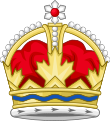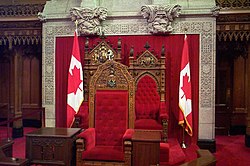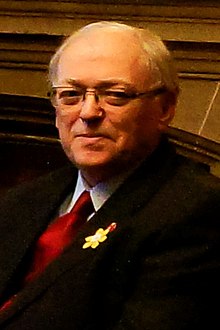Speaker of the Senate of Canada
| Speaker of the Canadian Senate | |
|---|---|
since December 3, 2015 | |
| Style | The Honourable |
| Appointer | Governor General on the advice of the Prime Minister |
| Term length | At Her Majesty's pleasure |
| Inaugural holder | Joseph Édouard Cauchon |
| Formation | November 5, 1867 |
| Salary | $212,600 (CAD) |
 |
|---|
The Speaker of the Senate of Canada (Template:Lang-fr) is the presiding officer of the Senate of Canada. The Speaker represents the Senate at official functions, rules on questions of parliamentary procedure and parliamentary privilege, and presides over debates and voting in the "Red Chamber". This position is often misunderstood as being equivalent to that in the House of Commons, but it is not. The current Speaker is George Furey who assumed office upon nomination by Prime Minister Justin Trudeau on December 3, 2015, replace Leo Housakos.[1]
Appointment and precedence
The Speaker of the Senate is appointed by the Governor General of Canada, on behalf of the Canadian Monarch, and on the Constitutional advice of the Queen's Privy Council for Canada. By convention, however, this advice is generally expressed exclusively by the Prime Minister of Canada (the "Governor-in-Council").
The Speaker of the Senate of Canada takes precedence only after the Queen of Canada, Elizabeth II, her Viceroy, the Governor General of Canada, other members of the Canadian Royal Family, former Governors General of Canada and their spouses, the Prime Minister of Canada, former Prime Ministers of Canada, and the Chief Justice of Canada in the Canadian Order of Precedence—and, therefore, is qualified to represent Canada at official state functions, both in Canada and abroad.
History of the speakership
The role of the Speaker in the Senate was originally based on that of the Lord Chancellor in the United Kingdom. In keeping with the role of the Lord Chancellor, the Speaker of the Senate was expected to be partisan; the Speaker of the Senate would, at all times, have the right to leave the chair, to participate in debates, and to hold an original vote—unlike the Speaker of the House of Commons, who has a vote only in the event of a tie.
The Speaker of the Senate was also similar to the Lord Chancellor in being considered equal to other Senators. Decisions of the chair were not binding on the Senate unless the Speaker's decision was also the pleasure of a majority of Senators. Also similar to the practice of the Lords was that the Speaker would not intervene unless another Senator brought the matter to the attention of the Speaker. Decisions from the chair remain subject to appeals from the Senate.
Canada has more recently departed from the traditions of the House of Lords, notably since 1991, when new rules for the Senate were adopted. The new Standing Orders have made it clear that the Speaker of the Senate could intervene without being called to do so by the Senate. The new Guidelines move the Senate further from the model of the self-governing practices of the House of Lords, and more toward the Chair-governed customs of the House of Commons.
The position was preceded by the Speaker of the Speaker of the Legislative Council of the Province of Canada.
Role of the Speakership
The Speaker of the Senate is historically responsible for deciding on points of order, only once risen by another Senator. However, with the 1991 amendments to the Standing Orders and Guidelines that govern the Senate of Canada, the Speakership has generally begun to assert its right to intervene, where appropriate, without being prompted to do so. Therefore, the Speaker is, broadly speaking, responsible for the maintenance of order and decorum in the Senate.
As a high-ranking individual on the order of precedence, the Speaker of the Senate often receives heads of state and heads of government — this role is not merely ceremonial; the speaker is a real delegate and representative of Canada abroad. They are expected to represent Canada internationally, and sometimes visit other nations on behalf of the Government of Canada.
While the Speaker is an officer of the Senate, the Speaker as Senator also remains a representative of the Province from which he or she was appointed. Unlike the Speaker of the House of Commons of Canada, the Speaker of the Senate of Canada has the right to participate in debates on behalf of the citizens of their Province or Territory. The Speaker has the right and power to cast an original vote, and to simultaneously preside over the voting process (rather than the Speaker merely delivering a tiebreaking vote, the question before the House is deemed to have been rejected).
Another significant difference between the two speakers is that the Speaker of the House of Commons of Canada holds a management role within the administration of the House of Commons of Canada as Chair of the Board of Internal Economy. The Speaker of the Senate holds no similar role, as the (Senate) Standing Committee on Internal Economy, Budgets, and Administration is chaired by another Senator.
In the absence of the Speaker in the Red Chamber, his duties are carried by the Speaker pro tempore, a Senator appointed at the beginning of each session by the Senate. Should both chair officers be absent, any Senator can be called upon to take the chair. Irrespective of who is in the chair, their decisions hold the same force as that of the Speaker of the Senate of Canada.
Ceremony
The Speaker of the Senate performs the Senate Speaker's Parade to mark the opening of a sitting in the Senate with the help of the Black Rod.[2]
List of Speakers of the Senate

Key:
Hays, Kinsella and Housakos are the only current living former Speakers of the Senate.
Several Speakers have died during their time in office:
- Josiah Burr Plumb 1888
- Hewitt Bostock 1930
- Georges Parent 1942
- Pierre Claude Nolin 2015
External links
- Speakers of the Senate — Official site, maintained by the Government of Canada.
References
- ^ Gloria Galloway (3 December 2015). "Liberals setting up advisory board to fill empty Senate seats". Globe and Mail.
- ^ "The Senate Speaker's Parade". Parliament of Canada. Retrieved 2013-06-16.

